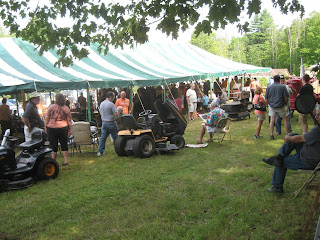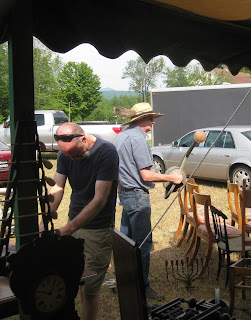The Navy Comes to Rockport,
2013
Three Naval Academy Sailboats visit Rockport July 12-14, 2013
Three
42-ft. Yachts of the Naval Academy Sailing Squadron visited Rockport this past weekend,
as did sailors from Portsmouth, NH and Newport,
RI, and the town rolled out the
welcome mat for them.
Roger Lesch, a retired local police
officer, and Sharon Grandmaison, who runs a child care service, are the driving
force behind the Rockport Navy Committee, which also includes people connected
to the American Legion, local fishermen, the Sandy Bay Yacht Club, the Rockport
Country Club, Navy veterans, friends of the Navy and old Naval Academy
graduates who live here.
It
is fascinating to see how Rockporters, and visitors, are attracted to these
sharp young men and women sailors and Midshipmen.
While the Navy was in town, we took
turns standing “watch” down on T Wharf where one of the boats was open for
visitors. Visitors to
Rockport strolled down the wharf to look at all the boats, and we offered them
a chance to visit the Naval Academy
yacht.
They’re usually eager to do it, and
clamber down the gangplank and lift themselves on board.
The Rockport Navy Committee had a whole schedule for these 30
Midshipmen and their advisors, including volleyball and softball games,
cookouts, a lobster feed, breakfasts at the First Baptist
Church and at Brackett's,
and many local merchants and citizens helped offer Rockport's hospitality.
The Navy Committee has done this for visiting warship crews in
recent years, as well.
Northeast Regional Navy Pops Ensemble as
they play a New Orleans
jazz number
Roger
and Sharon always do a spectacular job of organizing all the events of the Navy
Weekend, and this means getting families to sign up to house the midshipmen and
sailors, and organizing for feeding all these hungry young people, including a
lot of lobsters.
This
year the Northeast Regional Navy Pops Ensemble came, and Roger and Sharon set
up to give them all a fine lobster dinner before they played.
The
band with some 38 members, is a brilliantly professional organization, based at
the Naval War
College in Newport, RI. It amazed me how, on a hot summer day, these
musicians appear in perfect, spotless and crisply ironed white uniforms.
USNA Adult Advisor shows
visitors Academy Yacht
When I had my "watch" on T-Wharf last weekend, Advisor
and Skipper Hight Spencer, an adult with more time under canvas than most naval
officers, joined two of his Midshipmen crewmen
to show off their boat, and they showed off the cramped spaces for ten
midshipmen aboard the boat, and usually there was a conversation about life at
the Academy, and the Navy.
It’s interesting to talk with visitors
to Rockport, and Rockporters, who stroll down and go aboard the Navy
sailboats. They come from
all over the world.
USNA boat at sea
Summer cruises at the Academy have
always been very serious training events, with a little time squeezed in for the
Mids to see new lands and meet new people.
Midshipmen
spend their first summer at the Academy learning about the Navy, and getting
ready for four years of rigorous physical and academic life. From the day that they are sworn in,
their lives are a continuous whirlwind of marching drills, obstacle courses,
trips to the rifle range, swimming tests, whaleboat rowing, academic work,
running, hiking, sports, more marching, and lots of sweating.
The second summer is such a relief,
because Plebe year, and all the harassment and questions and drilling and
memorizing, sitting on an invisible stool at meals, and other forms of
“character building” are done. The
year of academics is done, and it is time to go to sea.
Today, some Midshipmen spend part of
that summer in these 42-foot sailboats, and they practice navigation, and learn
the finer points of handling a real sailing craft for several weeks. After that, they’ll fly to some base
in the United States or overseas, and embark in a submarine
or surface warship for several weeks.
On that ship they’ll learn what
enlisted men and women do that makes the ship operate and able to fight. They’ll learn how to make torpedoes or
missiles ready for firing, how to stand deck or diving station watches, how to
inspect tanks, how to charge batteries on a submarine, how to fuel ship, how to
navigate, and how to clean a head (crew’s toilets). This cruise as sophomores or
“Youngsters” is intended for them to get to see the Navy from the point of view
of enlisted men and women. The
next times they go to sea they’ll be studying the role of officers.
That “Youngster Cruise” of 2013 is not
much changed from the one we took aboard a battleship in 1954. (At least, from my point of view!)
As soon as the graduating class had
received their commissions and diplomas, we boarded troop transports from Annapolis down to Norfolk,
where we embarked in a summer training squadron. My ship was USS New Jersey (BB62), a
45,000 ton behemoth, with nine big 16-inch guns.
Four
Battleships Rendezvous off Norfolk,
June 1954
As soon as we were aboard, we sailed
out of Norfolk and
rendezvoused with three other battleships. The photo above shows that event,
which was the last time those marvelous veterans of World War II ever sailed
together. Besides New Jersey,
there were the Battleships Iowa, Wisconsin and Missouri. Missouri bore a large nameplate that marked the
location on her deck that had been the place for the signing of surrender
documents by the Empire of Japan that marked the end of World War II.
When this historic event was over, New Jersey and Missouri, two cruisers, many destroyers, a small carrier,
and some auxiliary ships, started our way across the Atlantic.
All the way across we worked, and
studied, stood watches, and worked at the jobs usually designed for enlisted
men, like cleaning compartments and washrooms, painting, loading stores,
assisting in taking on fuel, and much, much more.
The Jersey crew had just returned from
duty off Korea in the Korean War, firing those big
guns at North Korean targets.
In the evening there were movies
topside on deck, and once on the cruise a “Smoker” when men gathered on the
large teak deck aft, the fantail, to watch boxing matches between sailors, or
between midshipmen.
Crew
toilets in battleships resembled the bottom half of a large pipe, or
trough. Sailors sat on toilet seats across this half pipe, and sea water
flowed through the pipe, and then carried the waste overboard. At busy times, there might be a
dozen or more sailors all sitting on this half pipe.
At some
time or other, a wise guy would take a wadded up newspaper and set it afire,
and let it float in the halfpipe, upstream of the men sitting there. You can imagine the surprise as the
fire passed beneath the bottom of each man, and each popped up, in sequence.
Holystoning
Each Saturday at sea was Field Day,
with meticulous scrubbing from stem to stern, and midshipmen learned how to
holystone. This was a
long-observed job of lining up sailors, barefoot, on the teak decks of the
battleship and scrubbing those decks with soapy water until they shone. The device for scrubbing was a mop
handle stuck in the hole of a boiler fire brick. In a row of Mids, we rubbed the brick
back and forth on the deck, sliding and sloshing in the soapsuds, until a
senior Chief Petty Officer decided the deck was sparkling clean. Here’s a
video of sailors holystoning the decks of USS Missouri:
After
about two weeks of this life at sea, the ships arrived at their first liberty
port, and ours was Vigo, on the northwest (Atlantic) coast of Spain.
This part of Spain, just nine years after World
War II ended, was really poor. Many of the people who came to see our ship
come alongside the pier and tie up were barefoot.
They were poor, but Spaniards showed
the sailors and midshipmen aboard the battleship and other ships a marvelous
welcome, with dancing in the streets, a street fair, and loads of booths
selling all kinds of Spanish food and drink. I
recall a bottle of Spanish “champagne” sold for about one U.S. dollar.
We had tours of the town, and trips
just a few miles north to the very picturesque and historical city of Santiago
de Compostela.
Our next port was Cherbourg, France,
and there the battleship anchored out, and we took ferries to go ashore. The liberty boats returning sailors
and midshipmen to the battleship after an evening in the town could be
interesting.
I grew up in a non-drinking home in
Texas, and I had not really been exposed to people who routinely got very drunk
and fought with each other, using fists, feet, knives and firearms to maim and
kill each other.
Battleships were big in every way, and
with a complement of 2000 officers and men, there were always a few
troublemakers.
The Cherbourg liberty boat was really a large ferry
that could carry over 200 men, and one evening I was aboard along with a whole
load of enlisted men and midshipmen, and some were really drunk. One rather small, wiry sailor was
incredibly drunk, and started picking fights and then picked a fight with a
large sailor who was a Shore Patrolman. The
S.P. started to restrain the sailor, who then summoned up the superhuman power
only available to drunks, and swung the huge shore patrolmen around the deck
like a limp rag. Then, more
shore patrolmen showed up, and soon there must have been a dozen sailors
wheeling around, trying to restrain this little drunken man. When they
finally had him down, a hospital corpsman appeared and gave the man an
injection of something to quiet him down.
I’ve seen spectacular drunks quite a
few times in my thirty-four years in the Navy, but that was my introduction.
Ashore in Cherbourg, ten years after
the D-Day Invasion there against bitter Nazi opposition, there were still signs
of bomb and artillery damage, and graffiti about the then current war of French
troops fighting at Dienbienphu, in French Indo-China.
After a wonderful trip to Paris,
we were all back aboard New Jersey, and then sailed to Guantanamo, Cuba,
where we had a chance to fire those big 16-inch guns and experience life in
boiler rooms when the temperature reaches 130 degrees F. or more.
[NOTE:
This Blog first appeared in July, 2011.
It has been updated for this Navy visit.]

















